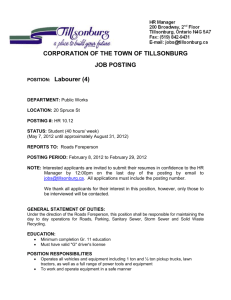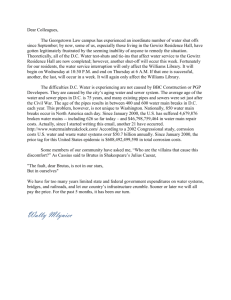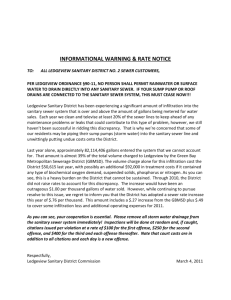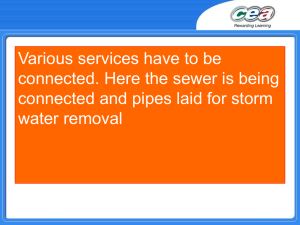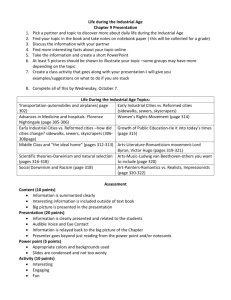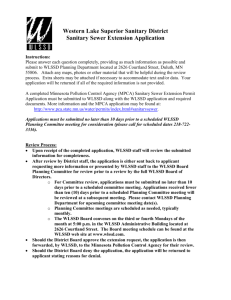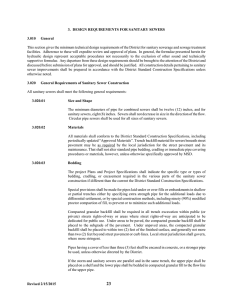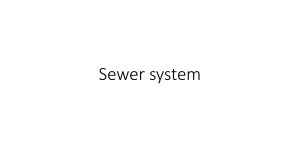State of Infrastructure
advertisement
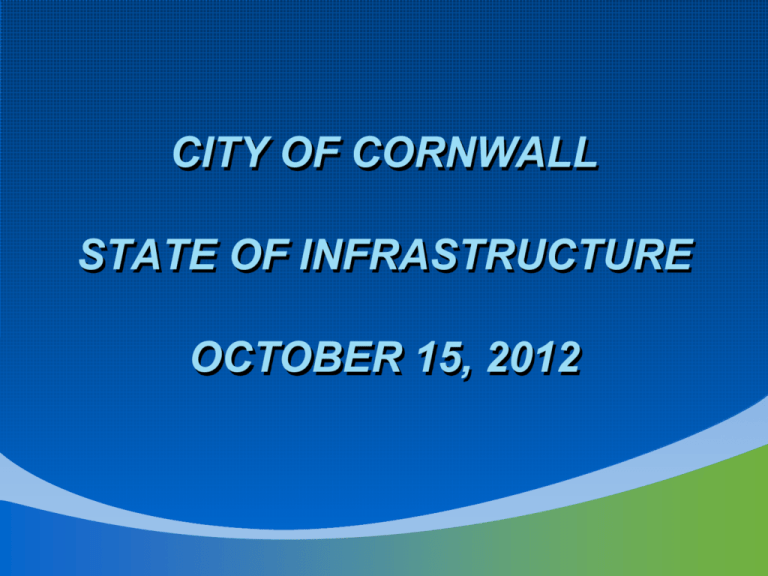
CITY OF CORNWALL STATE OF INFRASTRUCTURE OCTOBER 15, 2012 Assets Managed by Infrastructure Planning Division • Transportation Network • Sewer and Drainage Network • Water Network Transportation Network Roads Curbs Sidewalks Bridges Other Structures Traffic Signals Street Signs Street Lights 268.8 Km 337.2 Km 179.6 Km 11 22 large culverts, walls 66 intersections 9,200 5,100 Transportation Network, cont’d Roads by Official Plan (OP) Class Arterial 81.7 Km 30.4 % Collector 38.3 Km 14.2 % Local 148.8 Km 55.4 % Total 268.8Km Roads by Surface Material Asphalt 194.3 Km 72.3 % 59.1 Km 22.0 % Concrete 9.3 Km 3.5 % Other 6.1 Km 2.2 % Total 268.8Km Asphalt on Concrete Sewer Network Sanitary Pipes 188.9 Km Sanitary Manholes 2,420 Sanitary Pump Stations 5 Combined Pipes Combined Manholes Storm Pipes Storm Manholes 65.0 Km 750 127.1 Km 1,800 Storm Catchbasins SWM Facilities Main Drainage Ditches 4,490 7 29.5 Km Water Network Pressure Zones Water Pipes Fire Hydrants Valves – Excluding FH Valves 1 276.4 Km 1305 1900 Water Network, cont’d Watermain Pipe Materials Material Length (KM) Length (%) Cast Iron (1880 to 1919) 3.2 1.2 120 Cast Iron (1920 to 1939) 32.1 11.6 100 Cast Iron (after 1939) 73.4 26.6 75 Ductile Iron 48.5 17.6 90 Steel 2.1 0.8 55 Concrete Pressure Pipe 19.9 7.2 100 Polyvinyl Chloride (PVC) 90.4 32.7 110 2.2 50 + host pipe remainder Cured-In-Place (CIPP) Reline 6 Service Life (Yrs) Asset Value Sanitary Sewer (incl MH’s) $80.8M Combined Sewer (incl MH’s) $50.3M Storm Sewer (incl MH’s) $86.8M Water Network (incl valves & hydrants $151.0M Roads $208.0 M Bridges $17.2M Street Lights $14.3M Traffic Signals $4.5M Street Signs $2.4M Sidewalk $27.5M Structures – Culverts CSP Super span $1.5M Stormwater Main Drains $5.0M Stormwater Management Facilities $0.2M Sanitary Sewer Pump Stations $2.0M TOTAL Source: Asset Management Plan Ph 2, 2006 $651.5M Condition Investigation Roads • Regular road patrols by MW to address Minimum Maint Stds, O Reg 239/02 • Biannual condition evaluation => assigned Pavement Condition Rating (PCR) • Development of pavement deterioration curves Bridges & Structures • Biannual structure inspection – bridges, large span culverts (>3m), retaining walls • Identification of Bridge Condition Index, deficiencies for other structures Sidewalks • Condition assessment completed in 2012 • Graded from 1 (excellent) to 5 (poor) Condition Investigation, cont’d Sewers • Zoom camera inspect pipes at manhole junctions • CCTV inspect sewers that zoom screening identified as having structural concerns • Sewers rating based ona UK standard – Water Resources Centre (WRc) • Ratings are assigned for Structural Condition (SC) and Potential for Blockage (PB) SC Grade Implication 5 Collapsed or collapse imminent 4 Collapse likely in the near future 3 Collapse unlikely in near future but future deterioration likely 2 Minimal collapse risk in short term but potential for future deterioration 1 Acceptable structural condition Condition Investigation, cont’d Watermains • Closed system, more difficult than sewers to inspect • Pressurized network, where failure can damage adjacent facilities/buildings • Stresses and metal fatigue affect failure • Service life is a typically used proxy for condition, based on statistically developed deterioration models • Analysis of low free chlorine residual testing - 0.2mg/l to 0.5 mg/l • Modelled fire flow results – 5,000 l/m fire applied on max day Infrastructure Planning Documents • Asset Management Plan – Water, Wastewater & Transportation Networks • Phase 1 – August 2005 • Phase 2 – May 2006 • Critical Infrastructure Report – December 2006 • Interceptor & CSO Outlet Condition Investigation – November 2009 • Sewer Separation Plans • Fly Creek Area – 2002 • Brookdale and Lower Fly Creek - 2005 • Storm of Sept 30, 2010 Analysis - Ongoing Risk A combination of the probability of asset failure and a forecast of the severity of the direct and indirect impact – consequences – of failure on the level of service to customers and the environment. Asset Condition Demo Condition Summary Roads Condition PCR Length (Km) Percent Cdn Avg* Very Good 80-100 104.5 39.4 % 22 % Good 70-79 62.4 23.5 % 26 % Satisfactory 60-69 49.7 18.7 % Marginal 50-59 30.9 11.7 % 32 % Poor 40-49 16.3 6.1 % 17 % Very Poor <40 1.4 0.5 % 4% * Source: Canadian Infrastructure Report Card, Vol 1, 2012 Condition Summary, cont’d Bridges – 2010 Structure Inspection Condition BCI Number of Bridges Good 70-100 9 Fair 60-70 1 Poor <60 1 Condition Summary, cont’d Sidewalks Condition Length (Km) Percent 1 54.5 30.4 2 59.7 33.3 3 41.7 23.2 4 18.5 10.3 5 4.9 2.7 Condition Summary, cont’d Wastewater Stormwater Cond Length Percent (Km) Cdn Avg* Cond Length Percent (Km) Cdn Avg* 1 41.8 19.5 33.7 1 22.1 20.2 40.5 2 88.7 41.4 36.1 2 46.6 42.6 36.2 3 48.1 22.5 22.4 3 20.9 19.0 17.7 4 25.1 11.7 6.5 4 14.4 13.2 4.9 5 10.5 4.9 1.2 5 5.5 5.0 0.8 * Source: Canadian Infrastructure Report Card, Vol 1, 2012 Condition Summary, cont’d Watermains Remaining Years Length (Km) Percent 0-20 80.0 28.9 21-40 37.1 13.4 41-60 53.8 19.5 61-80 26.5 9.6 > 81 78.9 28.6 Average Annual Linear Infrastructure Expenditure 2008 - 2011 Roads Sewer Water Source: TCA annual asset additions $3.1 M $1.2 M $1.6 M What Needs to be Done? Renewal/Replacement/Repair of: Roads (PCR <60, Local Roads<55 38 Km Sidewalks 23 Km Sewers 55 Km Water 60 Km General Approach Combined Sewer Areas: • Oldest infrastructure and where combined sewers require separation • Typically reconstruction is recommended if funds are available Separated Sewer Areas: • These are newer areas typically meeting design standards • Rehabilitation of individual assets, shave & pave roadway Next Steps • Identify recommended intervention to address deficiency for each identified asset. • Prepare cost estimates for recommended work. • Prioritize interventions based on risk and coordination of asset needs. • Develop budget and financing alternatives.
